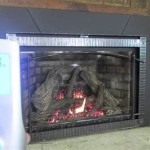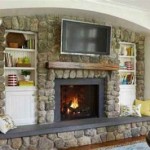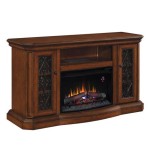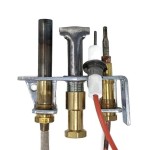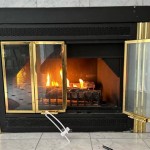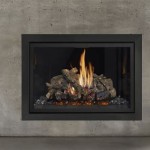Corner Fireplace Mantel: Design, Installation, and Considerations
A corner fireplace mantel presents a unique design opportunity within a living space. Unlike traditional fireplace arrangements centered on a wall, a corner fireplace maximizes space and creates a focal point that draws the eye in a different direction. This necessitates a careful consideration of the mantel's design, material, and installation to ensure both aesthetic appeal and functional safety.
The mantel, in its most basic definition, is a shelf or decorative framework above or around a fireplace. Functionally, it provides a non-combustible surface for displaying decorative items, family photos, or seasonal accents. However, its role extends beyond mere decoration. The mantel also serves as a visual break, contributing to the overall balance of the fireplace design. A well-chosen mantel anchors the fireplace, making it a cohesive element within the room.
Corner fireplaces offer a number of benefits. Notably, they can fit into smaller rooms more easily than a centrally placed fireplace. They also free up wall space for furniture placement, artwork, or other architectural features. The corner location can also create a cozy and intimate atmosphere, particularly when combined with comfortable seating arrangements.
Design Considerations for Corner Fireplace Mantels
Designing a corner fireplace mantel involves navigating several important factors. These include the overall style of the room, the type of fireplace, the available space, and the desired aesthetic. Ignoring any of these elements can result in a mantel that feels out of place or functionally inadequate.
Firstly, the architectural style of the room should inform the mantel's design. A modern room calls for sleek, minimalist designs with clean lines, perhaps using materials like concrete, metal, or glass. A more traditional space might benefit from a mantel crafted from rich wood with intricate carvings. A rustic or farmhouse style could incorporate reclaimed wood, stone, or brick elements. Maintaining consistency with the existing decor creates a harmonious and visually pleasing environment.
Secondly, the type of fireplace – wood-burning, gas, or electric – significantly influences mantel design. Wood-burning fireplaces generate substantial heat, requiring stricter adherence to building codes regarding clearances between the firebox opening and combustible materials. Gas fireplaces produce less heat, allowing for greater design flexibility. Electric fireplaces generate minimal heat, offering the widest range of design possibilities, including the use of materials that would be unsuitable for wood-burning fireplaces.
The available space is another crucial factor. In a small room, a bulky mantel can overwhelm the space and make it feel cramped. A smaller, more streamlined mantel is often the better choice. In a larger room, a more substantial mantel can serve as a prominent focal point. The mantel's depth should also be considered, ensuring it doesn't protrude too far into the room, obstructing traffic flow. The corner location itself also dictates the mantel's shape. Straight mantel shelves may require modification to fit neatly into the corner, while curved mantels can soften the angularity of the corner and create a more fluid design.
Finally, the desired aesthetic plays a major role. Whether the goal is to create a dramatic statement piece or a subtle complement to the existing decor, the mantel should reflect the desired ambiance. The choice of materials, colors, and finishes should align with the overall design vision. Consider the visual weight of the mantel; a dark, heavy mantel will draw more attention than a light, airy one. Think about how the mantel will interact with other elements in the room, such as artwork, furniture, and lighting. By carefully considering these design elements, it is possible to create a corner fireplace mantel that enhances the beauty and functionality of the living space.
Material Selection for Corner Fireplace Mantels
The choice of materials for a corner fireplace mantel significantly impacts its appearance, durability, and safety. The materials must complement the design style, withstand the heat generated by the fireplace (depending on the type), and adhere to building codes and safety regulations. Common materials include wood, stone, brick, concrete, and metal, each offering unique aesthetic and functional properties.
Wood is a popular choice due to its versatility, warmth, and affordability. Different wood species offer varying grains, colors, and textures. Hardwoods, such as oak, maple, and cherry, are durable and resistant to dents and scratches, making them suitable for high-traffic areas. Softwoods, such as pine and cedar, are more affordable but require more care. When using wood near a wood-burning fireplace, it's essential to ensure adequate clearance from the firebox opening to prevent combustion. A non-combustible barrier, such as a layer of brick or stone, may be necessary to protect the wood mantel from excessive heat. For gas or electric fireplaces, wood mantels are generally safer due to the lower heat output.
Stone, including marble, granite, and limestone, offers a timeless and elegant look. Stone is naturally non-combustible and can withstand high temperatures, making it an excellent choice for wood-burning fireplaces. Its durability and resistance to scratches and stains make it a low-maintenance option. However, stone can be expensive and heavy, requiring structural support to bear its weight. The color and veining patterns of stone vary widely, allowing for a range of design possibilities, from classic and traditional to modern and contemporary. The installation of a stone mantel typically requires professional expertise due to the weight and complexity involved.
Brick provides a rustic and charming aesthetic, often associated with traditional or farmhouse-style homes. Like stone, brick is non-combustible and can withstand high temperatures. Brick mantels can be constructed from new or reclaimed bricks, offering flexibility in terms of color and texture. Reclaimed bricks often have a weathered appearance that adds character and authenticity. Brick mantels can be relatively affordable, especially when using reclaimed materials. The installation of a brick mantel requires masonry skills and attention to detail to ensure a structurally sound and visually appealing finished product.
Concrete is a versatile material that can be molded into various shapes and finishes, making it suitable for modern and contemporary designs. Concrete mantels can be cast in place or precast, offering flexibility in size and shape. Concrete is non-combustible and can withstand high temperatures, making it safe for use with wood-burning fireplaces. Concrete can be stained or polished to achieve different colors and textures. Its smooth surface and clean lines make it a popular choice for minimalist designs. The weight of concrete can be a concern, requiring structural support to ensure stability. Professional installation is often recommended for concrete mantels.
Metal, including steel and wrought iron, offers a modern and industrial aesthetic. Metal mantels are durable, fire-resistant, and relatively lightweight. Steel mantels can be powder-coated in different colors to match the room's decor. Wrought iron mantels often feature intricate designs and can add a touch of elegance to the fireplace. Metal mantels are suitable for gas and electric fireplaces and can be used with wood-burning fireplaces with appropriate heat shielding. Metal can be prone to rust if not properly treated, especially in humid environments. The installation of a metal mantel is generally straightforward, but professional assistance may be required for custom designs.
Installation Considerations for Corner Fireplace Mantels
Proper installation of a corner fireplace mantel is critical for both safety and aesthetics. Incorrect installation can lead to structural instability, fire hazards, or an aesthetically displeasing result. The installation process varies depending on the type of mantel, the fireplace, and the wall construction. It is recommended to consult with a qualified professional, especially when dealing with heavy materials or complex installations.
Before beginning the installation, it is crucial to verify local building codes and regulations regarding fireplace mantel clearances and fire safety. Building codes often specify minimum distances between the firebox opening and combustible materials, such as wood mantels. Adhering to these requirements helps prevent fire hazards and ensures compliance with safety standards. It is also important to obtain any necessary permits before starting the installation.
The first step in the installation process is to prepare the corner area. This involves ensuring that the wall is structurally sound and free of any obstructions. If the existing wall is not strong enough to support the weight of the mantel, it may be necessary to reinforce it with additional framing. The wall surface should be clean and level to provide a stable base for the mantel. If the fireplace is new, it should be installed according to the manufacturer's instructions before installing the mantel.
For wood mantels, the installation typically involves attaching a support structure to the wall. This support structure can be made from wood or metal and should be securely fastened to the wall studs or concrete using appropriate fasteners. The mantel is then attached to the support structure using screws, nails, or construction adhesive. It is essential to ensure that the mantel is level and plumb. Gaps between the mantel and the wall can be filled with caulk or wood filler to create a seamless appearance.
For stone, brick, or concrete mantels, the installation process is more complex due to the weight and size of the materials. These mantels often require a concrete or steel lintel to support their weight. The lintel should be securely anchored to the wall and level. The mantel sections are then carefully placed on the lintel and secured with mortar or construction adhesive. It is crucial to ensure that the mantel sections are properly aligned and level. Temporary supports may be necessary to hold the mantel in place while the mortar or adhesive cures. Professional installation is highly recommended for these types of mantels.
For metal mantels, the installation typically involves attaching a mounting bracket to the wall. The bracket should be securely fastened to the wall studs or concrete using appropriate fasteners. The mantel is then attached to the mounting bracket using screws or bolts. It is essential to ensure that the mantel is level and plumb. Metal mantels are often lightweight and easy to install, but professional assistance may be required for custom designs or complex installations.
After the mantel is installed, it is important to inspect it thoroughly to ensure that it is structurally sound and aesthetically pleasing. Check for any gaps, cracks, or loose connections. Touch up any imperfections with paint, caulk, or wood filler. Finally, decorate the mantel with your favorite items to create a warm and inviting focal point in the room.

How To Decorate A Corner Fireplace Mantel For The Holidays Making It In Mountains

How To Make A Corner Fireplace Mantel Look Good 15 Examples

Corner Mantle Fireplace Decor Fall Home

Corner Rustic Fireplace Mantel Custom Made For Inside And Outside Corners

16 Best Corner Fireplace Mantels Ideas

Corner Stone Fireplace Mantel Idea

How To Make A Corner Fireplace Mantel Look Good 15 Examples

Master Bedroom Cream Beveled Corner Fireplace Mantel Transitional

32 Best Corner Fireplace Ideas For 2024 Decor Home Gas Living Room With

Akward Corner Fireplace Mantel What To Do
Related Posts


